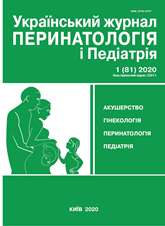Intrauterine growth restriction in the structure of perinatal losses
DOI:
https://doi.org/10.15574/PP.2020.81.34Keywords:
intrauterine growth restriction, perinatal mortality, perinatal outcomes, stillbirthAbstract
Purpose — to determine the role of fetal growth retardation in the structure of stillbirth by a retrospective analysis of the history of childbirth.Patients and methods. a retrospective analysis of the course of 532 single pregnancies ended in stillbirths that occurred during the period from 2014–2018 in gestation periods of 23–40 weeks in the Zaporizhzhia region was carried out. Criteria for exclusion from the study were: multiple pregnancies, the presence of chromosomal abnormalities in the fetus, undefined gestational age in the first trimester.
Results and conclusions. The analysis of perinatal losses in the Zaporizhzhia region over the past five years showed an increase in perinatal mortality due to the number of stillbirths. The results of the study allowed us to establish that the vast majority of women with FGR belong to the low-risk group (women without somatic pathology and complicated pregnancy). High rates of perinatal mortality in the Zaporizhzhia region indicate the problem of both timely diagnosis of FGR and tactics of further pregnancy management. Nowadays, predicting the risk of antenatal death in fetuses with FGR remains an unresolved problem.
The research was carried out in accordance with the principles of the Helsinki Declaration. The study protocol was approved by the Local Ethics Committee of this Institute. The informed consent of the patient was obtained for conducting the studies.
No conflict of interest were declared by the authors.
References
MOZ. (2005). Pro zatverdzhennya klinichnih protokoliv z akusherskoyi ta ginekologichnoyi dopomogi. Nakaz MOZ 782 vid 29.12.2005 roku. URL: https://zakon.rada.gov.ua/go/v0782282-05.
Chepelevska LA, Rudnickij OP. (2018). Analiz demografichnoyi situaciyi v Ukrayini. Shorichna dopovid pro stan zdorov'ya naselennya, sanitarno-epidemichnu situaciyu ta rezultati diyalnosti sistemi ohoroni zdorov'ya Ukrayini. 2017 rik. MOZ Ukrayini, DU «UISD MOZ Ukrayini». Kyiv: MVC «Medinform»: 15—19. https://dspace.uzhnu.edu.ua/jspui/bitstream/lib/22919/1/ЩД_за_2017_рік.pdf.
Blencowe H, Cousens S, Bianchi JF et al. (2016). National, regional, and worldwide estimates of stillbirth rates in 2015 with trends since 1995: a systematic analysis. Lancet Global Health. 4: 98—108. https://doi.org/10.1016/S2214-109X(15)00275-2
Figueras F, Gratacos E. (2017). An integrated approach to fetal growth restriction. Best Pract Res Clin Obstet Gynaecol. 38: 48—58. https://doi.org/10.1016/j.bpobgyn.2016.10.006; PMid:27940123
Figueras F, Gratacуs E. (2014). Update on the Diagnosis and Classification of Fetal Growth Restriction and Proposal of a Stage-Based Management Protocol. Fetal Diagn Ther. 36: 86—98. https://doi.org/10.1159/000357592; PMid:2445781
Gardosi J, Madurasinghe V, Williams M et al. (2013). Maternal and fetal risk factors for stillbirth: population based study. BMJ. 346: f108. https://doi.org/10.1136/bmj.f108; PMid:23349424 PMCid:PMC3554866
Goldenberg R. (2011). Stillbirths: the vision for 2020. Lancet. 377 (9779): 1798—1805. https://doi.org/10.1016/S0140-6736(10)62235-0
Heazell AP, Hayes DL, Whitworth M et al. (2019). Biochemical tests of placental function versus ultrasound assessment of fetal size for stillbirth and small for gestational age infants. Cochrane Database of Systematic Reviews. Issue 5. Art. No.: CD012245. https://doi.org/10.1002/14651858.CD012245.pub2; PMid:31087568
Kiserud T, Piaggio G et al. (2017). The World Health Organization Fetal Growth Charts: A Multinational Longitudinal Study of Ultrasound Biometric Measurements and Estimated Fetal Weight. PLoS Med. 14 (1): 1—36. https://doi.org/10.1371/journal.pmed.1002284; PMid:28339475 PMCid:PMC5365101
Sharma D, Shastri S, Farahbakhsh N. (2016). Intrauterine growth restriction — part 1. The Journal of Maternal-Fetal & Neonatal Medicine. 29(24): 3977—3987. https://doi.org/10.3109/14767058.2016.1152249; PMid:26856409
Smith G. (2018). Universal screening for fetal growth restriction. Best Pract Res Clin Obstet Gynaecol. 49 (5): 16—28. https://doi.org/10.1016/j.bpobgyn.2018.02.008; PMid:29571820
Spencer R, Ambler G, Brodszki J et al. (2017). EVERREST prospective study: a 6-year prospective study to define the clinical and biological characteristics of pregnancies affected by severe early onset fetal growth restriction. BMC Pregnancy Childbirth: 17—43. https://doi.org/10.1186/s12884-017-1226-7; PMid:28114884 PMCid:PMC5259830
Downloads
Issue
Section
License
The policy of the Journal “Ukrainian Journal of Perinatology and Pediatrics” is compatible with the vast majority of funders' of open access and self-archiving policies. The journal provides immediate open access route being convinced that everyone – not only scientists - can benefit from research results, and publishes articles exclusively under open access distribution, with a Creative Commons Attribution-Noncommercial 4.0 international license(СС BY-NC).
Authors transfer the copyright to the Journal “MODERN PEDIATRICS. UKRAINE” when the manuscript is accepted for publication. Authors declare that this manuscript has not been published nor is under simultaneous consideration for publication elsewhere. After publication, the articles become freely available on-line to the public.
Readers have the right to use, distribute, and reproduce articles in any medium, provided the articles and the journal are properly cited.
The use of published materials for commercial purposes is strongly prohibited.

